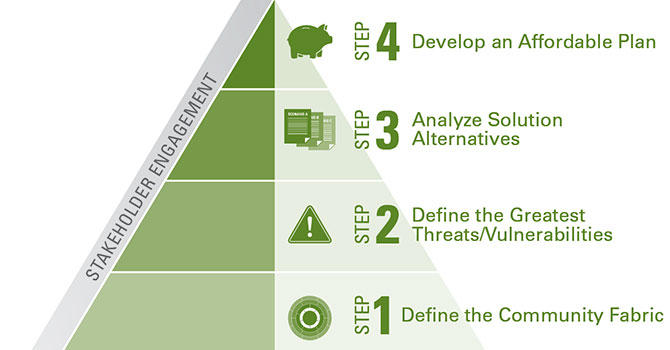Community resilience planning has increasingly become a necessity for municipalities across the country. With natural disasters occurring frequently, from unexpected tornados in the aftermath of a storm to flooded neighborhoods after a heavy rainfall, communities are developing mitigation strategies to combat future effects of natural disasters.
Standardized Planning
The National Academy of Sciences explored the idea of creating a resilience ranking system to categorize cities and towns throughout the country. The ranking would be based on various categories including capital, the disaster risk management cycle, theme, and four properties of resilience: robustness, resourcefulness, rapidity, and redundancy.
In theory, this method would make it possible to give communities a resilience ranking, a tool that would allow us to understand a community's strengths and weaknesses. This would enable towns to be compared with neighboring towns and create common solutions for future planning. However, the challenge with a ranking like this is no two places are exactly the same. How could a ranking be developed so that it was all-encompassing and repeatable for every community?
Customized Planning
From my experience, the cookie-cutter approach to community resilience planning is basing a community's planning options on calculations and data from other towns. Every city is not identical, even similar locations have different needs. During my time with the U.S. Army, I worked to deliver solutions for flood risk management issues and developed floodplain management results during response efforts for nine hurricanes and 14 floods. I learned that what sparks a community and brings residents back to normalcy after a disaster is different for every community. In some places, reopening schools was the main priority, in others, it was getting the fueling stations functional. For some, it was the transportation nodes, and, for others, opening the public buildings. If the same resilience formula was used for all of these places, the communities would not have been restored to what their residents considered livable conditions. Resilience planning should be customizable for every community to guarantee their specific requirements are addressed.
There is more value in creating a distinctive plan for future disasters to restore a community to its "normal" level of functionality instead of utilizing cookie-cutter planning to prevent future disasters. At Dewberry, we think true resilience involves:
- Identifying what is most important and critical to the community
- Anticipating threats that would adversely impact that critical activity
- Mitigating those threats
- Recovering from the adverse events and returning to normal
This multidisciplinary approach embraces the entire life cycle of resilience, incorporates sustainability, provides a greater understanding of the threats while reducing the impacts of known potential risks, and identifying the risks of inaction.

The steps outline the levels of client engagement we use when identifying a community's needs.
Future Flood Resilience Action Plan
In Southern Virginia, we performed a comprehensive sea level rise (SLR) and recurrent flooding analysis and planning study that helped a coastal city prepare for anticipated increases in flood impacts due to SLR. The assessment helped to identify vulnerabilities and clarify real threats. We are developing response plans to offset current and future recurrent flooding issues for susceptible areas across the city's unique watersheds. Each watershed will receive a tailored adaptation plan incorporating strategies that encompass planning, policy, and engineering solutions.
These studies will be combined with feasibility assessments and benefit-cost ratios to help prioritize strategies, which can best be implemented to improve flood resilience and enable the long-term sustainability of the community.
Capital Improvement Action Plan
For a port city in New Jersey, we presented a detailed analysis of risk to infrastructure and operations from coastal hazards and SLR. Our study included identifying critical infrastructure and operations, assessing and mapping future hazards, risk assessment, and establishing adaptation strategies. The end goal of this project was for the client to be aware of existing and future hazard conditions, along with targeting strategies to increase resilience through the planned investments in the port.
While these coastal cities are facing similar obstacles, their priorities for returning to normal operation are distinct. They both have separate goals for what is a necessity for resilience planning. If they were categorized by a standard resilience ranking to determine what their plan of action should be after a natural disaster, I believe the results for both projects would be similar and collectively unbeneficial.
There Can Be a Better Future
The customized approach to community resilience planning is the best option for communities to return to normalcy after a disaster. It allows for each study and assessment to be conducted based on specific needs or threats, so the results are tailored to a community's unique identity. Our clients seek us after experiencing recurring climate issues or a natural disaster and are looking for the best possible solution for future planning. We help them identify a shared vision of a prepared resilient community.
MAT MAMPARA ON COMMUNITY RESILIENCE